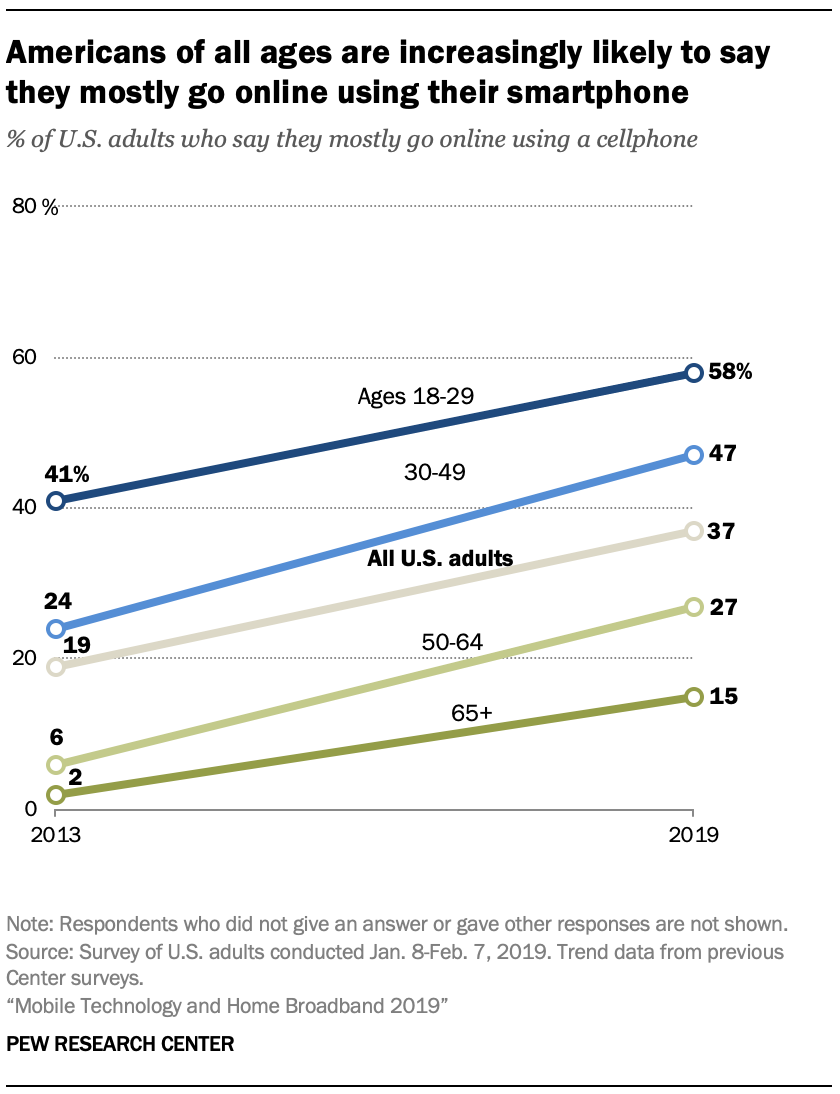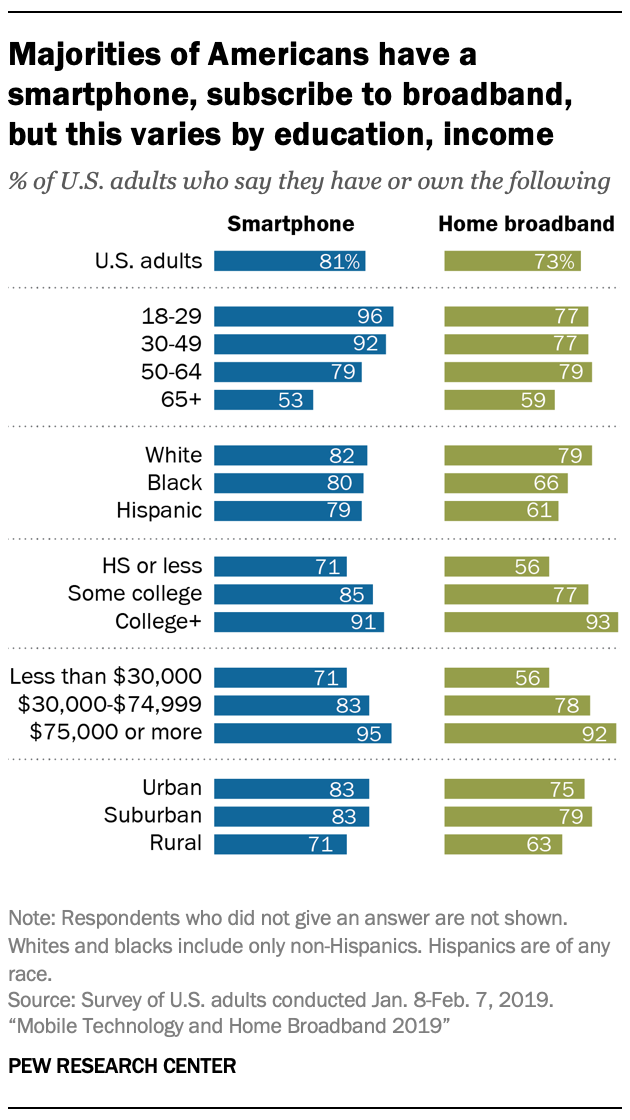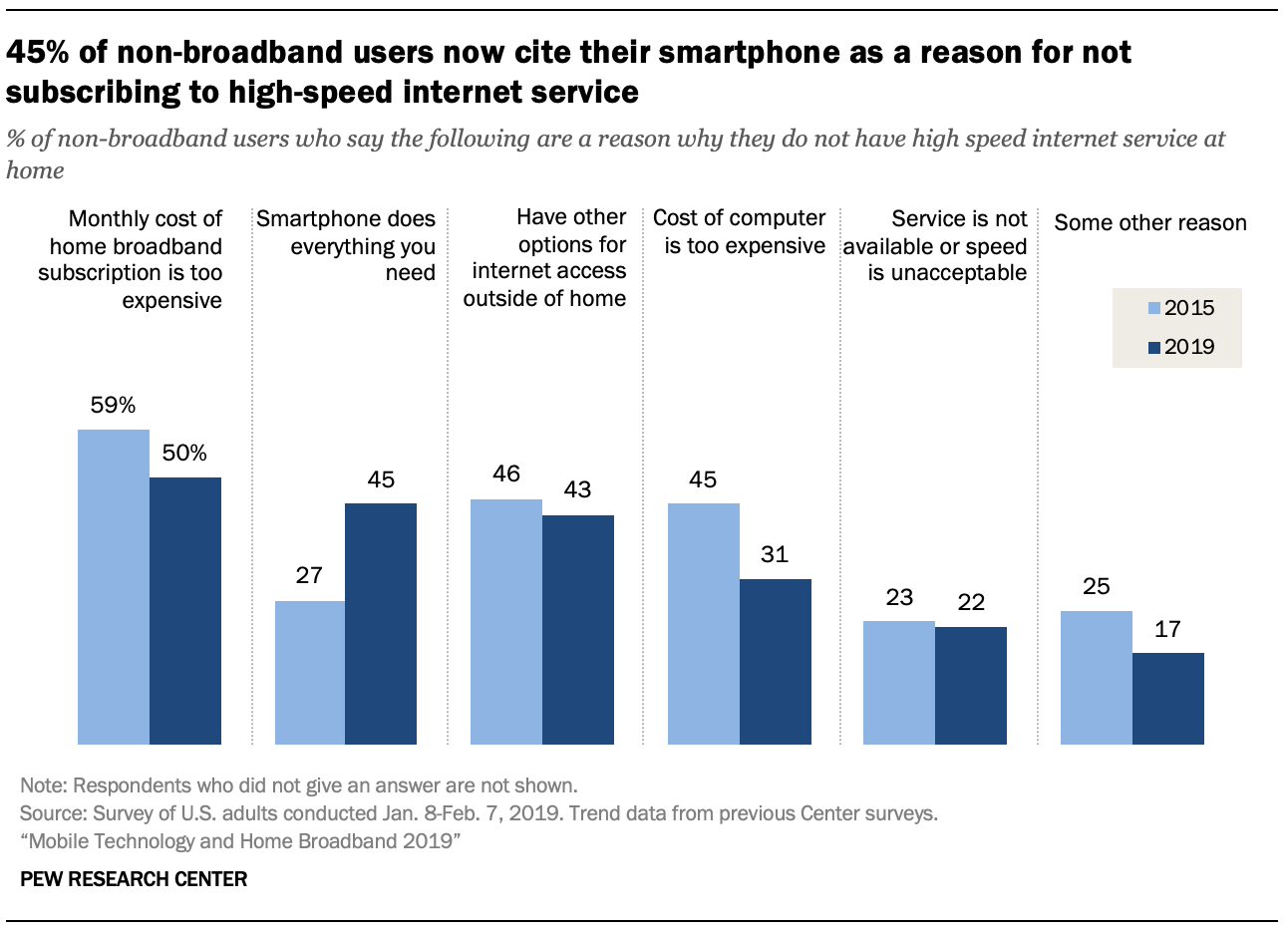Mobile Technology and Home Broadband 2019
37% of Americans now go online mostly using a smartphone, and these devices are increasingly cited as a reason for not having a high-speed internet connection at home
(Hero Images/Getty Images)
As the share of Americans who say they own a smartphone has increased dramatically over the past decade – from 35% in 2011 to 81% in 2019 – a new Pew Research Center survey finds that the way many people choose to go online is markedly different than in previous years.
 Today, 37% of U.S. adults say they mostly use a smartphone when accessing the internet. This share has nearly doubled since 2013, when the Center last asked this question. At that point, 19% of Americans named their smartphone as their primary device for going online.
Today, 37% of U.S. adults say they mostly use a smartphone when accessing the internet. This share has nearly doubled since 2013, when the Center last asked this question. At that point, 19% of Americans named their smartphone as their primary device for going online.
Younger adults are especially likely to reach for their phones when going online. Fully 58% of 18-to 29-year-olds say they mostly go online through a smartphone, up from 41% in 2013. Still, this growth is evident across all age groups. For example, the share of adults ages 30 to 49 who say they mostly use a smartphone to go online has nearly doubled – from 24% in 2013 to 47% today.
 These trends are part of a broader shift toward mobile technology that has changed the way people do everything from getting news to applying for jobs.
These trends are part of a broader shift toward mobile technology that has changed the way people do everything from getting news to applying for jobs.
Indeed, mobile devices are not simply being used more often to go online – some Americans are forgoing traditional broadband at home altogether in favor of their smartphone. A majority of adults say they subscribe to home broadband, but about one-in-four (27%) do not. And growing shares of these non-adopters cite their mobile phone as a reason for not subscribing to these services.
Among non-broadband users, 45% say they do not have broadband at home because their smartphone lets them do everything they need to do online, up from 27% in 2015. At the same time, the share of non-broadband users who say their smartphone is the most important reason for not having a high-speed internet connection where they live has nearly doubled over the same time period (from 12% to 23%). And while affordability remains a commonly cited barrier, the share of non-broadband adopters who say the cost of a monthly subscription is the most important reason for not having these services has fallen from 33% in 2015 to 21% today.
In addition, 80% of these non-broadband users say they are not interested in getting high-speed connections at home.
These patterns underscore the reliance that a minority of Americans have on their smartphone for internet access. Some 17% of U.S. adults are “smartphone-only internet users” – meaning they report owning a smartphone but do not have a traditional high-speed internet connection where they live. This share has roughly doubled since 2013, when 8% of adults fell into this category.
These are some of the key findings from Pew Research Center’s telephone survey of 1,502 U.S. adults conducted Jan. 8 – Feb. 7, 2019.
A majority of Americans subscribe to high-speed internet service at home or own a smartphone, but digital gaps remain between some groups
 Fully 81% of adults now say they own a smartphone, up slightly from 77% in 2018. Smartphone ownership is relatively common among Americans of different economic, educational and racial and ethnic backgrounds. Adults ages 65 and older are the only major demographic group in which a clear majority do not own this type of device, but ownership rates vary even within this population: 59% of those ages 65 to 74 are smartphone owners, but that share falls to 40% among those 75 and older.
Fully 81% of adults now say they own a smartphone, up slightly from 77% in 2018. Smartphone ownership is relatively common among Americans of different economic, educational and racial and ethnic backgrounds. Adults ages 65 and older are the only major demographic group in which a clear majority do not own this type of device, but ownership rates vary even within this population: 59% of those ages 65 to 74 are smartphone owners, but that share falls to 40% among those 75 and older.
The share of Americans who say they have broadband service at home has also risen slightly over the past year – from 65% in early 2018 to 73% today. But compared with smartphone ownership, there are more pronounced variations in broadband adoption across demographic groups. For example, 92% of adults from households earning $75,000 or more a year say they have broadband internet at home, but that share falls to 56% among those whose annual household income falls below $30,000. That 36-point gap in broadband adoption between the highest- and lowest-income groups is substantially larger than the 24-point gap in smartphone ownership between these groups. Educational differences follow a nearly identical pattern.
And as has been true with other Center surveys, there are double-digit gaps in home broadband adoption by community type, as well as by race and ethnicity.
Roughly one-in-four lower-income adults are “smartphone only” internet users
 For some Americans without traditional broadband, smartphones may help bridge these gaps in connectivity. Overall, 17% of Americans are now “smartphone only” internet users – meaning they own a smartphone but do not subscribe to broadband internet service at home. This share has roughly doubled since 2013. At that time, just 8% of Americans relied on their smartphone for internet use at home. The 2019 figure is, however, somewhat lower than the percentage who said this in 2018 (20%).
For some Americans without traditional broadband, smartphones may help bridge these gaps in connectivity. Overall, 17% of Americans are now “smartphone only” internet users – meaning they own a smartphone but do not subscribe to broadband internet service at home. This share has roughly doubled since 2013. At that time, just 8% of Americans relied on their smartphone for internet use at home. The 2019 figure is, however, somewhat lower than the percentage who said this in 2018 (20%).
In general, smartphone reliance tends to be more common among groups who also have lower levels of broadband adoption. Some 26% of adults who have a high school education or less are smartphone only internet users. By comparison, 16% of those with some college experience and only 4% of college graduates fall into this category. Lower-income adults are also more likely than those in higher-earning households to be smartphone only internet users.
Racial and ethnic gaps are also present: One-quarter of Hispanics and a comparable share of blacks are smartphone only internet users, compared with about one-in-ten whites.
Smartphone users are now more likely to go online using their mobile phone than with some other type of device
 For those who own a smartphone, these devices now outpace more traditional means of accessing the web. Some 46% of smartphone owners say when using the internet, they mostly do so on their phone. This represents a double-digit increase from 2013, when 34% of these users said this.
For those who own a smartphone, these devices now outpace more traditional means of accessing the web. Some 46% of smartphone owners say when using the internet, they mostly do so on their phone. This represents a double-digit increase from 2013, when 34% of these users said this.
At the same time, the share of smartphone users who say a desktop, laptop or tablet computer is their primary device for going online has fallen from 53% in 2013 to 30% today. Roughly one-quarter of smartphone users say they equally use a cellphone or a desktop, laptop or tablet computer when going online, up from 12% six years prior.
 Smartphone users’ preferred method of going online varies significantly by age. While 60% of smartphone owners ages 18 to 29 and roughly half of those ages 30 to 49 say they mostly use their cellphone to use the internet, those shares fall to about one-third or less among those ages 50 and older. On the other hand, smartphone users ages 50 and over are about twice as likely as those under the age of 50 to say they mostly access the internet through a computer of some kind (43% vs. 21%).
Smartphone users’ preferred method of going online varies significantly by age. While 60% of smartphone owners ages 18 to 29 and roughly half of those ages 30 to 49 say they mostly use their cellphone to use the internet, those shares fall to about one-third or less among those ages 50 and older. On the other hand, smartphone users ages 50 and over are about twice as likely as those under the age of 50 to say they mostly access the internet through a computer of some kind (43% vs. 21%).
Beyond age, there are also educational differences in the way smartphone users access the internet. Roughly six-in-ten smartphone owners with a high school diploma or less (57%) say they mostly use the internet via a cellphone, compared with 45% of smartphone users with some college experience and 34% of those with a bachelor’s degree or more. By contrast, smartphone owners who are college graduates are about twice as likely as those with a high school education or less to say they mostly use a computer to go online (40% vs. 21%). Similar gaps are present by household income and race and ethnicity. (For more details on how different demographic groups access the internet, see Appendix A.)
A growing share of non-broadband users cite their smartphone’s capabilities as the reason they do not subscribe to high-speed internet service at home
The reasons non-broadband users cite for not having broadband service have shifted in recent years. Affordability remains a commonly cited barrier to subscribing to these services, but the shares of non-broadband adopters who mention cost has declined since 2015.

Half of non-broadband users today say they do not subscribe to broadband because the cost of a monthly subscription is too expensive, while 31% say the cost of a computer is too expensive. In 2015, those shares were 59% and 45%, respectively.
Meanwhile, a growing share of non-broadband users credit their smartphone as a reason why they forgo a subscription to high-speed home internet service. Some 45% of non-broadband adopters say they do not have high-speed internet at home because their smartphone lets them do everything online that they need to do. This represents an 18 percentage point increase from 2015, when only 27% of non-adopters cited their smartphone as a reason for not having home broadband.
Roughly four-in-ten non-adopters report having other options for internet access outside of their home, while 22% say broadband service not being available or available at an unacceptable speed where they live is a reason for not subscribing to home broadband. Both of these shares have changed little in the past four years.
 When asked to name the most important reason they do not subscribe to home broadband, more non-adopters point to the functionality of their smartphones today than in the past.
When asked to name the most important reason they do not subscribe to home broadband, more non-adopters point to the functionality of their smartphones today than in the past.
Some 23% of non-broadband users say the most important reason for them not having a broadband connection at home is because their smartphones let them do everything they need to do online – roughly doubling the share (12%) who said this in 2015.
And while financial factors remain a frequently cited reason for non-adoption, fewer non-broadband users cite cost as the primary reason they do not subscribe to these services. Some 21% of non-broadband users say the monthly cost of service is the single most important reason why they do not have broadband at home, with an additional 6% attributing their non-adoption to computers being too expensive. In each case, both of these shares were higher in 2015 (33% and 10%, respectively).
And for non-broadband users who own a smartphone, the functionality of their smartphone is the single most important reason they cite for not subscribing to high-speed internet at home. Some 37% of non-broadband adopters who have a smartphone say this, statistically unchanged from 2015. At the same time, roughly one-quarter of non-broadband users who have a smartphone say either the monthly cost of a broadband subscription (22%) or the cost of a computer (4%) is the primary reason they do not have home broadband, down from 38% in 2015.
A majority of non-broadband users have never had high-speed internet at home and relatively few are interested in having it in the future
In previous Center surveys, Americans of all kinds have linked not having broadband to a number of disadvantages – including difficulties finding job information or less access to government services. Despite these perceived challenges, non-adopters show little interest in becoming home broadband users in the future.
 Six-in-ten non-broadband users say they have never had high-speed internet service at home in the past, while one-third indicate that they had previously subscribed to these services. And when asked if they are interested in having home broadband in the future, most non-adopters are unenthusiastic about the prospect. Fully 80% of non-broadband users say they would not be interested in having broadband at home, while 18% think this is something they would consider in the future. These sentiments are on par with those found in the Center’s 2015 survey.
Six-in-ten non-broadband users say they have never had high-speed internet service at home in the past, while one-third indicate that they had previously subscribed to these services. And when asked if they are interested in having home broadband in the future, most non-adopters are unenthusiastic about the prospect. Fully 80% of non-broadband users say they would not be interested in having broadband at home, while 18% think this is something they would consider in the future. These sentiments are on par with those found in the Center’s 2015 survey.



























Follow Us
Were this world an endless plain, and by sailing eastward we could for ever reach new distances